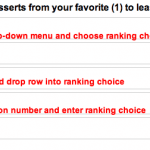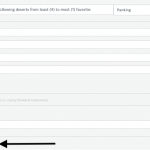So you want to know what people like the best, right? What sweet treat is considered the crème de la crème of your fave restaurant’s dessert list? Who do your students think should get the gold star for teacher of the year? Maybe you want to create a top ten list of this year’s best (or worst) movies? Well, you’re in the right place, dear customers. You can do all that and more in your surveys thanks to our handy-dandy Ranking Question!
The Ranking question option is an interactive and fun survey design choice. Your respondents can choose to click into the number field and type in their rankings, use their mouse to drag-and-drop their choices or they can choose from a drop down menu. As a heads-up for your survey respondents, you may want to include some additional text letting them know their answer choices will move automatically once they start ranking away.
Let’s take a peek.

Now what about calculating those averages based off of your respondents’ answers? We’ve got you covered. The ranking choices will always be weighted with equivalent value. For example, in our question above, if we rank “Cake” as our number one choice, this will be calculated with a weight of 1.
If you’d like to include the N/A option, go ahead and check off the option for this when creating your question. That way, it will be counted as “0,” but won’t be calculated into the averages which would throw them off.

So your Ranking question is all set up–let the games begin. Who knows? Maybe that movie everyone said was a flop turns out to be a hit thanks to your survey? Perhaps you’ll get your just desserts when you find out that floury mess in the kitchen was all worth it as your guests happily chow down on your specialty cakes.
Regardless of the outcome, you’ll know that you came out #1 at survey design!



